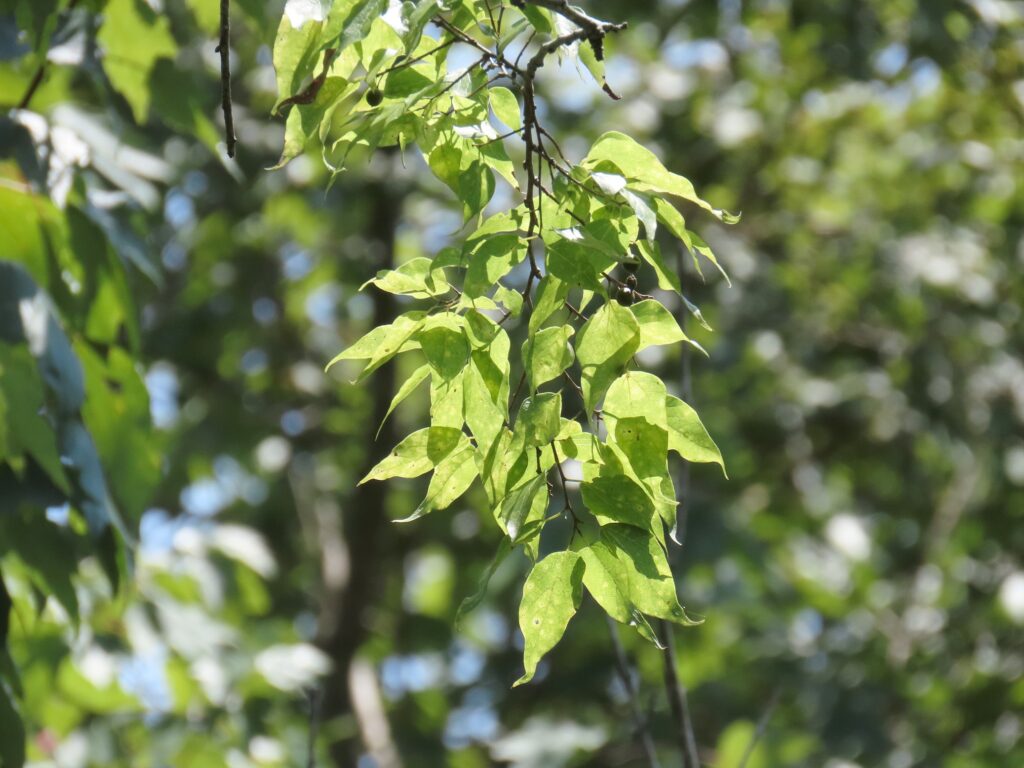




This week for Flora and Fauna Friday we have a lumpy, bumpy tree of the lowlands and Sea Islands, Southern Hackberry (Celtis laevigata).
Here in South Carolina we have three species of Hackberry. The Common Hackberry (C. occidentalis) and the Dwarf Hackberry (C. tenuifolia) are uncommon and rare respectively within the Lowcountry. However, the Southern Hackberry (C. laevigata), also called Sugarberry, can be found readily across all of South Carolina and most of the United States. Southern Hackberry prefers the fertile, moist soils of river floodplains on the mainland but is a highly adaptable tree able to grow and thrive on a wide array of soils. Here, on the young sandy soils of the Sea Islands, it is abundant most everywhere. It is even tolerant of salt spray and saltwater intrusion, finding itself at home in the maritime forests of our barrier islands, hammock islands, and even on rice field dikes and dredge spoil sites!
Southern Hackberry is an easily identifiable tree. It’s deciduous, emerald green leaves have a teardrop shape, round at the base with an elongate, pointed tip, as well as infrequent small serrations on the leaf margin. Its bark is a pale gray drifting to khaki and textured heavily with terraced corky projections. These corky warts can be barely visible or several inches long and over an inch tall, giving Hackberry trunks a look like little else in the Lowcountry! In full sun on sandy soils, Southern Hackberry grows incredibly fast, usually up to about forty feet high here on Edisto Island, with a crown just as wide of disordered branches pointing every which way. Because Hackberry is so fast growing, it has value as a timber species for cheap wood products like crates, veneer, and plywood. Its wood is fairly workable for carpentry and is very easy to steam bend, making it one of the most versatile and cost effective lumbers for building furniture here in the United States. It’s also adept as a shade tree in parks, yards, and suburban areas.
The Hackberry name apparently came from the Scottish word “hagberry”, a common name for the European tree species Bird Cherry (Prunus padus). Bird Cherry is a small tree found extensively in Eurasia which prefers wet areas and whose fruits are well used by birds. Our Southern Hackberry shares a similar significance to our native birds.
Many of our resident birds make meals out of the fruits of Southern Hackberry, better called by its other namesake of Sugarberry here. Although it produces drupes and not berries, these fruits are indeed a sugary snack sought after by fruit eating birds in winter and fall. They’re even edible by humans too. Southern Hackberry is also a host plant for two of our native butterflies, the aptly named Hackberry Emperor (Asterocampa celtis) and its ruddy cousin the Tawny Emperor (A. clyton). On that same note, Southern Hackberry is a “buggy” tree, it attracts a lot of insects. That also means it attracts a lot of birds! I’ve found Southern Hackberry to be one of the best trees to sit under during fall songbird migration to get good looks at migratory warblers, who come to feast upon the insects feasting upon the Hackberry. And while we’re talking about bugs, I need to touch on an invasive pest that has begun to pester our native Hackberries.
The Hackberry Woolly Aphid (Shivaphis celti) is as invasive pest from Asia with a perfectly succinct common name. These little aphids are coated from head to two in threads of blue-white wax which resembles wool and feed on the sap of our native Hackberries. The Aphid was first found in the United States in 1996 and has spread throughout the Southeast since. Thankfully, research indicates that an aphid infestation, even when prolific, has minimal impact to the trees themselves. It of course saps some of their vigor but appear not to cause any long term health issues. However, the “honeydew” dropping of these aphids (a mix of water, sugar, and wastes) coats everything beneath the tree in sticky sugar water, promoting the growth of molds which then stain leaves, trunks, sidewalks, cars, and anything else below. Thus, despite their adeptness for urban use as a hardy and fast growing tree, Hackberries are no longer being recommended for use in urban parks and residential developments due to the mess its pests bring with it. A real shame for this wonderful native tree.
And before I let you go, I have a pet hypothesis that Hackberry Woolly Aphids are actually a sought after food source by fall migrating Warblers, Vireos, and other insectivorous songbirds. These aphids are abundant and nutritious, Hackberries grow best in the hardwood forests these songbirds prefer to use during migration, resident “nuclear” species that attract migrant mixed flocks already make good use of this tree for its fruits, and I see a high diversity of migrating warblers in Hackberries in fall when the aphids are most abundant. Yet, I surprisingly found only a single piece of scientific research that references this idea, as an offhand hypothesis. [2009 Dobbs, Barrow, et al.] So there’s a free research topic for you budding young ornithologists out there!